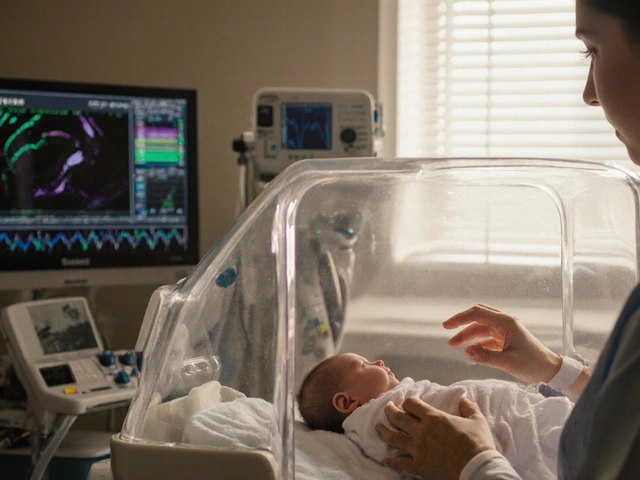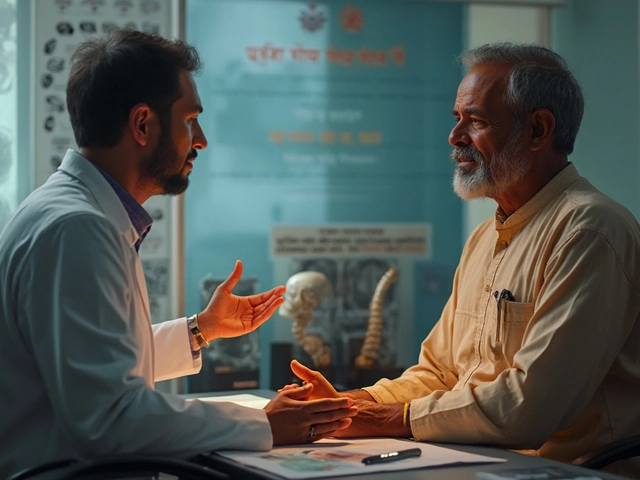Cancer is a disease that can affect anyone, but understanding its stages is crucial for anyone navigating a diagnosis. In particular, stage 3 and stage 4 represent pivotal moments in a cancer patient's journey, each with its unique challenges and considerations.
While they share the term ‘advanced,’ their implications for treatment and prognosis can differ significantly. In this article, we'll delve into what sets these stages apart, what they mean for patients, and perhaps most importantly, why this knowledge matters. With a bit of insight and clarity, facing the unknown can be just a bit less daunting.
- Defining Cancer Stages
- Characteristics of Stage 3 Cancer
- Progression to Stage 4 Cancer
- Treatment Options at Each Stage
- Living with Advanced Cancer
Defining Cancer Stages
Understanding the foundation of cancer staging is pivotal for interpreting diagnoses and crafting an effective treatment plan. Cancer staging is an intricate system that doctors use to describe the severity of an individual’s cancer. This staging system primarily assists in determining the nature and extent of cancer in the body. By characterizing the size of the initial tumor, its growth into nearby tissues, and its spread — if any — to lymph nodes or distant organs, one can grasp how advanced the cancer has become. The widely recognized model for this is the TNM system, which categorizes cancer based on three components: Tumor, Nodes, and Metastasis.
The Tumor (T) component indicates the size and extent of the main tumor. A higher number or letter following the T indicates a larger tumor or more extensive invasion into neighboring tissues. The Nodes (N) reflect whether cancer has spread to neighboring lymph nodes, which play a crucial role in the body’s immune response. Lastly, Metastasis (M) explains whether cancer has moved to distant organs beyond the original region. The TNM stages range from Stage 0 to Stage 4. Stage 0 signifies carcinoma in situ, a very early form where there’s no invasion into nearby tissues. Now, stage 3 cancer is typically associated with larger tumors or greater spread to nearby lymph nodes but hasn’t yet metastasized to distant sites. In contrast, stage 4 cancer involves metastasis, marking cancer that has reached more remote areas of the body.
Stage 4 cancer intrigues many due to its daunting nature, but understanding its framework can make it less intimidating. Though every cancer behaves differently, at its core, Stage 4 represents cancer that hasn't just lingered but ventured beyond its initial confines. Some propose it as advanced or even metastatic cancer. Here, awareness becomes power, opening individuals to new conversations and treatment approaches. A poignant insight sometimes highlighted is that not all Stage 4 cases lead to similar fates, providing a sense of hope and potential.
"In understanding cancer stages, patients unlock the context of their condition, helping guide not just treatment, but life choices." – National Cancer Institute.
To visualize how varied the progression through these stages can be, consider the following data. In a comprehensive study across different cancers, it was found that patient survival rates drastically vary based on the stage at diagnosis. Here's a simple representation of hypothetical survival statistics for an unspecified cancer:
| Stage | 5-Year Survival Rate |
|---|---|
| Stage 1 | 95% |
| Stage 2 | 80% |
| Stage 3 | 60% |
| Stage 4 | 30% |
This table isn't definitive for all cancers, but it illustrates a general trend: as the stage increases, the complexity and challenges rise. Without understanding these structures, navigating treatment paths could feel like walking blindly in an unfamiliar landscape. Thus, equipping oneself with this knowledge shines a little light on an otherwise shadowy path.
Characteristics of Stage 3 Cancer
Stage 3 cancer is often characterized by its more extensive nature compared to the earlier stages. In this phase, the cancer usually has not only increased in size but has also spread to nearby lymph nodes. It is known as a locally advanced cancer. This spread, however, typically does not reach distant organs, which is a distinguishing factor when compared to Stage 4 cancer. Depending on the type of cancer, the specifics of Stage 3 can vary, but the common theme is an escalation in its growth and involvement within the regional anatomy.
Patients diagnosed with Stage 3 cancer often face a more complex treatment regimen, which may involve a combination of surgery, radiation, and chemotherapy. The primary goal at this stage is often to reduce the tumor size and diminish the cancer's extent to prevent progression to Stage 4. According to the American Cancer Society, the five-year survival rates can differ significantly based on the cancer type, highlighting the nuances and individual challenges posed by this stage. A strategic and aggressive treatment approach aids in managing the disease effectively during this critical phase.
The symptoms experienced by individuals with Stage 3 cancer can be more pronounced due to the tumor's larger size and its effect on surrounding tissues. This can lead to symptoms such as persistent coughing, noticeable lumps, and changes in organ function, depending on the location of the cancer. Recognizing such symptoms early is vital, as it can lead to a more timely diagnosis and initiation of the necessary interventions. It's crucial for patients to maintain open communication lines with their healthcare team to understand these evolving symptoms' impact and management.
In many instances, Stage 3 cancer requires a multidisciplinary approach to treatment, involving various specialists who collaborate to create a comprehensive treatment plan. This plan might include the expertise of oncologists, surgeons, radiologists, and nursing teams who together aim to tackle the disease from multiple angles. As such, understanding the logistical and emotional burdens of treatment can be equally essential for patients and caregivers alike. The intricacy of managing such a diagnosis underscores the need for awareness and education to make informed decisions about care and symptom management.
"Cancer is an uninvited visitor, yet the resolve of both patients and caregivers can create an atmosphere where hope prevails over despair," said Dr. Sidney Farber, a pioneer in chemotherapy research, epitomizing the spirit required to face a Stage 3 diagnosis.

Progression to Stage 4 Cancer
When we talk about cancer progression, moving from stage 3 to stage 4 cancer is a significant transition for patients and their families. Stage 3 often indicates that the cancer has grown larger and invaded nearby tissues or lymph nodes, but it hasn’t yet spread to distant organs. This concept of distant spread is where stage 4 comes into play, defined by cancer's ability to metastasize to other parts of the body. This transition changes the landscape of feasible interventions and brings a new set of challenges and considerations for both treatment and quality of life.
One crucial fact about this progression is related to how cancer cells break away from the primary tumor and travel, typically via the bloodstream or lymphatic system, to establish themselves in new, remote locations. This is why stage 4 is often termed as metastatic cancer. For instance, a person who initially has breast cancer might develop secondary tumors in the liver or bones. This spread not only complicates treatment but also impacts prognosis, as it suggests a more complex biological behavior of the cancer cells. According to the American Cancer Society, metastasis remains the primary reason cancer can be fatal, as it involves multiple organ systems beyond the original tumor site.
Cancer metastasis is a highly complex process that encompasses multiple biological mechanisms and factors that influence how cells spread and grow. - National Cancer Institute
The pathways and mechanisms of cancer spread involve numerous biological determinants, including the genetic makeup of the cancer, the surrounding environment of the original tumor, and even the body's immune response. Recent research suggests that some cancer cells are particularly adept at evading the immune system, allowing them to colonize distant organs. Understanding these mechanisms is vital for developing new therapies that could potentially disrupt the spread of cancer at various stages. Remarkably, some ongoing studies have started exploring how modifying the tumor's microenvironment or blocking certain pathways could halt or slow down this progression.
Once cancer moves into stage 4, treatment strategies often shift focus from curative efforts to palliative care aimed at prolonging life and enhancing comfort. Options like chemotherapy, targeted therapy, immunotherapy, or a combination of these are tailored to manage symptoms and control growth. The importance of maintaining a support system cannot be overstated, as emotional and psychological well-being play pivotal roles in patient care. In some cases, clinical trials become a viable option, offering access to emerging therapies. It's crucial to evaluate all available options with healthcare providers, considering both the potential benefits and impacts on quality of life. These decisions are best made as part of a comprehensive discussion involving the patient, oncologists, and loved ones to chart a path forward that aligns with personal values and health goals.
Treatment Options at Each Stage
When it comes to battling cancer, understanding potential treatment options is crucial for both patients and their families. This knowledge not only empowers but also aids in making informed decisions. For stage 3 cancer, treatments often focus on eliminating the tumor and preventing any spread to adjacent areas. Surgery is a common choice at this stage, especially if the tumor is localized, and surgeons aim to meticulously remove cancerous tissues. Often, this surgical approach is complemented with radiation therapy, which targets residual cells that surgery might have missed. Alongside radiation, chemotherapy plays a critical role by acting systemically to kill cancer cells throughout the body. This combination approach, termed multimodal therapy, increases the chances of controlling the disease effectively.
Patients diagnosed with stage 4 cancer face a different set of challenges. At this advanced stage, cancer is not confined and has spread to other parts of the body, restricting the possibility of curative surgery. The treatment focus shifts towards managing and controlling the disease to manage symptoms and improve quality of life. Systemic treatments such as chemotherapy and targeted therapy become predominant. Targeted therapy zeroes in on specific molecules involved in cancer growth, offering a more precise attack while sparing healthy cells. In recent years, immunotherapy has emerged as a beacon of hope for stage 4 patients. By enhancing the body's immune response against cancer cells, it has shown promising results in extending survival and improving life quality. It's worth mentioning a quote by Dr. Siddhartha Mukherjee, a renowned oncologist, who once said, "Cancer’s invisibility is its survival strategy, but targeted and immunotherapies are reconfiguring the rules of engagement."
Additionally, for both stages, participating in clinical trials can open pathways to cutting-edge therapies not yet widely available. Clinical trials are meticulously designed and can provide access to new drugs or combinations of treatments. It's essential for patients to discuss with their oncologists the potential benefits and risks involved. Supportive care, addressing physical, emotional, and psychological aspects, is integral at every step, ensuring patients have the fullest life possible. Pain management, nutritional support, and counseling services are invaluable parts of comprehensive cancer care. Ultimately, treatment decisions are complex, and every patient's journey is unique. It's vital to consult medical professionals who can tailor treatments based on individual health profiles, preferences, and evolving clinical expertise.

Living with Advanced Cancer
Living with stage 3 or stage 4 cancer presents a labyrinth of emotions and decisions. It's a chapter defined by resilience, adaptability, and, often, redefining one's sense of normalcy. The day-to-day can feel unpredictable, yet within that unpredictability, many find moments of profound clarity and strength. The physical symptoms of advanced cancer—pain, fatigue, and treatment side effects—can feel like a steep hill to climb. Yet, it's the emotional rollercoaster that many patients cite as the most challenging. Coping strategies vary, but often include a mix of medical management and supportive therapies, each playing a crucial role in maintaining quality of life.
Embracing a multidisciplinary approach to cancer treatment can be pivotal. Beyond chemotherapy or radiation, treatments like targeted therapy or immunotherapy offer potential benefits for patients with advanced illness. As the landscape of treatment evolves, patients find themselves navigating not only medical decisions but also their emotional landscapes. Seeking support from psychological counseling or peer support groups can provide the emotional anchor needed during this journey. Connection with others who understand the path because they're walking it too can provide a sense of comforting camaraderie. Each story shared reinforces that no one is truly alone in this experience.
Managing Relationships and Expectations
Relationships, too, undergo significant shifts when cancer enters the picture. Whether it’s with a spouse, family member, or friend, understanding and communication become even more critical. Maintaining open dialogues about limits, needs, and expectations can help avoid misunderstandings and offer support where it’s most needed. For many, the fear of becoming a burden looms large. Yet loved ones often wish for nothing more than to be part of the caregiving team. Educating them about the realities of stage 3 cancer or stage 4 cancer can foster empathy and clarity, providing a space for genuine and informed support.
"Living with cancer means making every day count, finding joy in small victories, and leaning on those who uplift and understand you." - Anonymous Cancer Survivor
One significant aspect of advanced cancer is learning to balance hope with reality. Hope drives many to engage in clinical trials or explore alternative treatments. Yet, understanding the trajectory of the illness and acknowledging potential outcomes is a nuanced dance of optimism and realism. A strong dialogue with healthcare providers about goals of care is essential, ensuring that medical efforts are aligned with personal values and desires.
Exploring Palliative Care
Palliative care often gets misunderstood as giving up on treatment, yet it is quite the opposite. It focuses on enhancing comfort and quality of life at any stage of cancer. Whether managing symptoms or providing emotional support, palliative care teams can play a transformative role in this journey. A study found that patients enrolled in palliative care early in the course of disease had improved quality of life and potentially even longer survival rates.
- It provides pain and symptom management tailored to individual needs.
- Offers support to families and caregivers, preparing them for the dynamic journey.
- Aids in making complex treatment decisions, aligning interventions with personal goals.
- Encourages discussions around advanced care planning, creating peace of mind for both the patient and family.
Death is a part of life, yet for many facing advanced cancer, it's a topic that can bring unease. Discussing end-of-life preferences through advanced care directives or living wills can provide peace for both the patient and their loved ones. Embracing the reality of one's mortality can, paradoxically, rekindle the importance of life’s precious moments. Emphasizing the pursuit of meaningful experiences often becomes a source of profound comfort. For many, spirituality or a deeper connection to nature provides solace, adding a dimension of peace that transcends the physical body.





